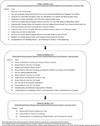Incorporating prosocial behavior to promote physical activity in older adults: rationale and design of the Program for Active Aging and Community Engagement (PACE)
- PMID: 23876672
- PMCID: PMC4041385
- DOI: 10.1016/j.cct.2013.07.004
Incorporating prosocial behavior to promote physical activity in older adults: rationale and design of the Program for Active Aging and Community Engagement (PACE)
Abstract
Despite the benefits of regular physical activity among older adults, physical activity rates are low in this population. The Program for Active Aging and Community Engagement (PACE) is an ongoing randomized controlled trial designed to compare the effects of two interventions on physical activity at 12 months among older adults. A total of 300 men and women aged 55 years or older will be randomized into either a healthy aging (HA) control intervention (n = 150), which is largely based upon educational sessions, or a prosocial behavior physical activity (PBPA) intervention (n = 150), which incorporates structured physical activity sessions, cognitive-behavioral counseling, and opportunities to earn food for donation to a regional food bank based on weekly physical activity and volunteering. The PBPA intervention is delivered at a local YMCA, and a regional grocery store chain donates the food to the food bank. Data will be collected at baseline, 3, 6, and 12 months. The primary outcome is physical activity as assessed by the Community Healthy Activities Model Program for Seniors (CHAMPS) Questionnaire at 12 months. Secondary outcomes include physical function and health-related quality of life. If successful, the PACE study will demonstrate that prosocial behavior and volunteerism may be efficaciously incorporated into interventions and will provide evidence for a novel motivating factor for physical activity.
Trial registration: ClinicalTrials.gov NCT01528761.
Keywords: Community partnership; Older adults; Physical activity; Prosocial behavior; Randomized controlled trial.
© 2013.
Figures
References
-
- Chodzko-Zajko WJ, Proctor DN, Fiatarone Singh MA, Minson CT, Nigg CR, Salem GJ, et al. Exercise and physical activity for older adults. Med Sci Sports Exerc. 2009;41:1510–1530. - PubMed
-
- Dishman RK. Overview. In: Dishman RK, editor. Exercise adherence: its impact on public health. Champaign, IL: Human Kinetics Press; 1998.
-
- Census Bureau Population Division. Propulation Projections Branch. U.S. Interim Projections by Age, Sex, Race, and Hispanic Origin - Table 2. 2004
-
- Rejeski WJ, Foy CG, Brawley LR, Brubaker PH, Focht BC, Norris JL, et al. Older adults in cardiac rehabilitation: a new strategy for enhancing physical function. Med Sci Sports Exerc. 2002;34:1705–1713. - PubMed
-
- Stewart AL, Mills KM, King AC, Haskell WL, Gillis D, Ritter PL. CHAMPS physical activity questionnaire for older adults: outcomes for interventions. Med Sci Sports Exerc. 2001;33:1126–1141. - PubMed
Publication types
MeSH terms
Associated data
Grants and funding
LinkOut - more resources
Full Text Sources
Other Literature Sources
Medical





